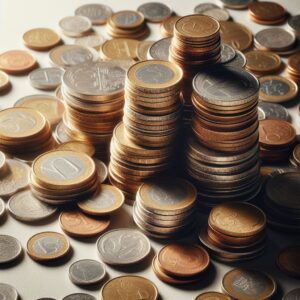Complete Travel Guide to Visiting Khinaliq, Azerbaijan (2024)
10 min readA complete travel guide for Khinaliq (AKA Xinaliq, Khinalug), Azerbaijan’s high-altitude village where homestays and hiking reign supreme.
There are several villages in the South Caucasus that vie for the title of the region’s – and even Europe’s – highest. Perched on a plateau 2,180 metres (7,152 feet) above sea level, Khinaliq is certainly a contender.
No one disputes the fact that this is the highest continuously inhabited village in Azerbaijan. And, as of 2023, it is the region’s newest UNESCO World Heritage Site.
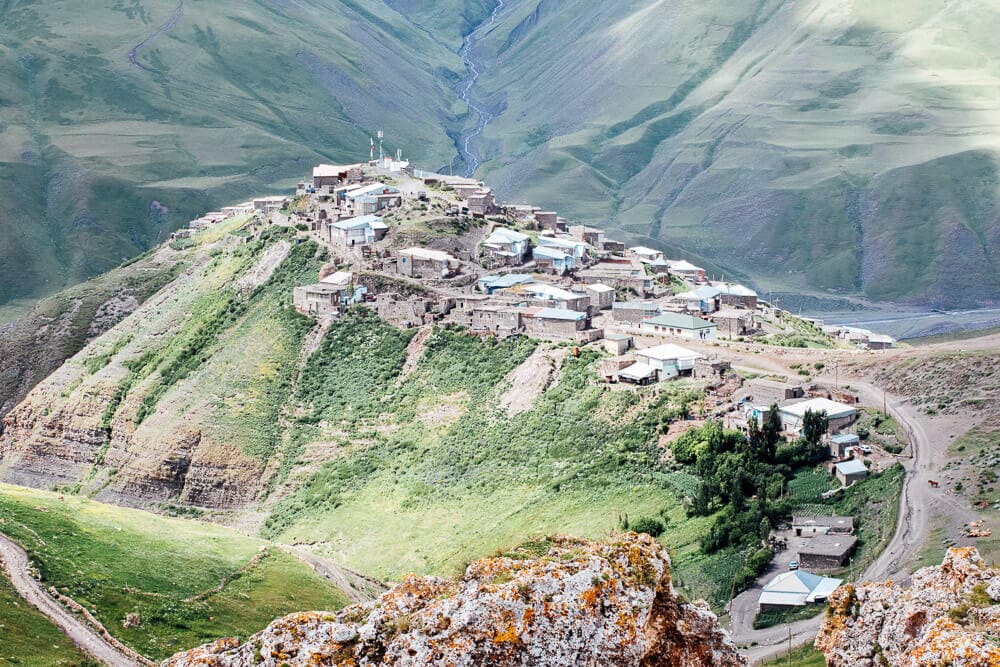
Khinaliq is primarily a destination for hiking in Azerbaijan and for homestays. Easy enough to reach from Baku in around four hours via Quba, I consider it an essential component of any travel itinerary for those who wish to experience a slice of adventure Caucasus-style.
I was lucky enough to visit Khinaliq on the eve of the UNESCO designation with one of the conservationists who worked on the application. Because of this, I got some intimate insights into Khinaliq’s living culture and the Transhumance migration route.
I was travelling on a writing assignment without my camera – so please excuse the phone photos!
In this guide, I will share my tips for planning a trip to Khinaliq plus what to do when you get there.
Please note: This post contains affiliate links, meaning I may earn a commission if you make a purchase by clicking a link (at no extra cost to you). Learn more.
Why visit Khinaliq?
Aside from the bragging rights that come with visiting Azerbaijan’s most remote village, Khinaliq is a rewarding travel destination where you can find a slightly more ‘authentic’ perspective on life outside the capital. It is primed for tourism, but it is certainly far less commercialised than Lahic, for example.
Hiking and outdoor adventures are the main thing to do in Khinaliq. There are several trails that start from the village, including a stage of the Transcaucasian Trail.
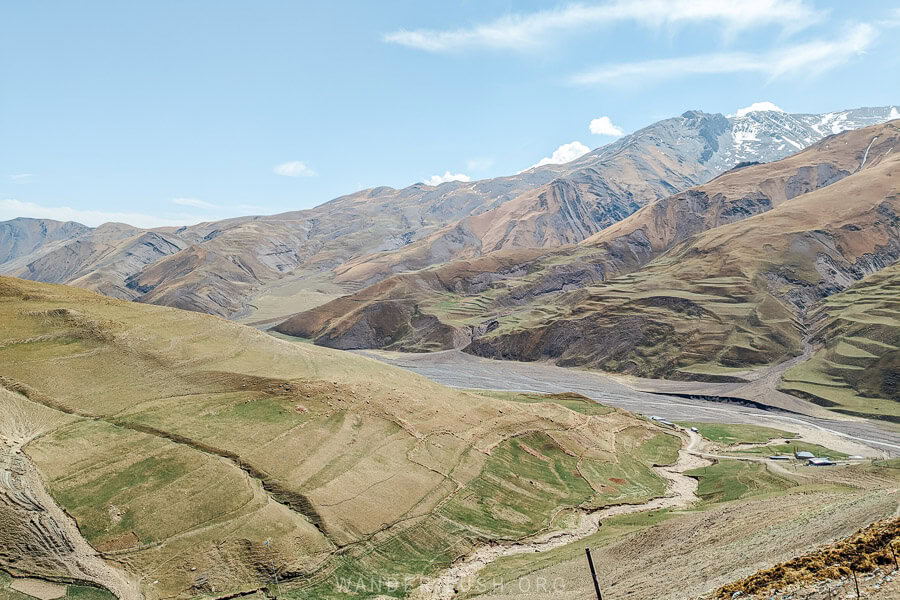
Khinaliq is also a cultural destination. Its recent UNESCO designation – the Cultural Landscape of Khinalig People and “Köç Yolu” Transhumance Route – relates to the ancient semi-nomadic tradition where families move between the high mountains and lowlands every spring and autumn.
The UNESCO ‘zone’ covers both the village itself, and the passage of land that shepherds ascend and descend twice a year.
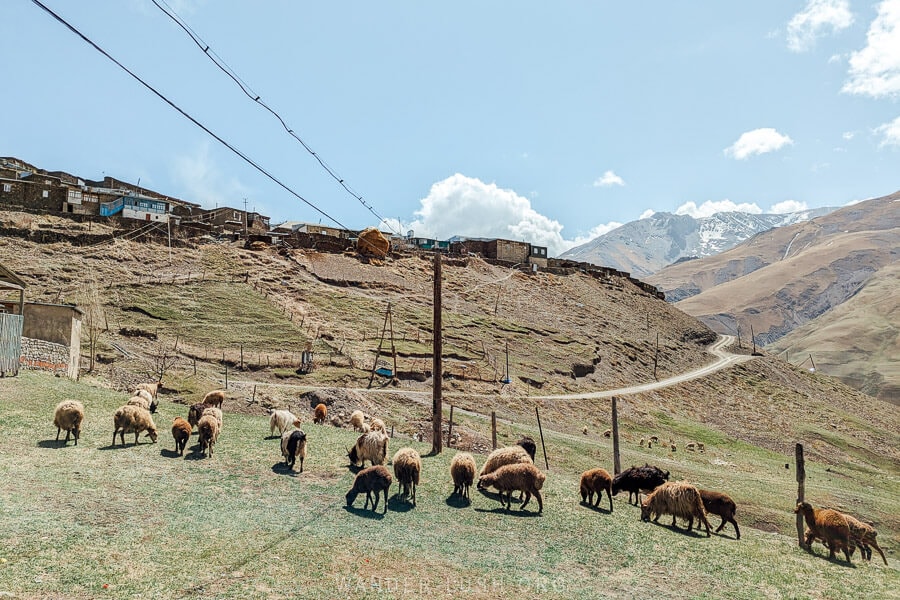
Khinaliq is thought to be around 5,000 years old – and according to locals, their forefather is none other than Noah. All 2,000 residents speak a distinct language called Khinalug, and belong to one of four families, each of which has its own burial grounds and special symbols that women use in carpet weaving.
Back in 2006, Khinaliq received its first paved road, connecting the once-isolated village to Quba and Baku with greater ease than ever before.
How to get to Khinaliq from Baku
Khinaliq is located roughly 230 kilometres (143 miles) from Baku via the E119 Highway. The first part of the journey follows the Caspian Coast. After turning inland, you come to the city of Quba, which is the traditional departure point for Khinaliq. This is your last opportunity to stock-up on snacks and more importantly, to withdraw cash (there are no ATMs in Khinaliq).
From Quba, it takes another 1.5-2 hours to reach Khinaliq via the mountain road. It is quite steep and narrow, but it is fully paved and honestly in great shape all things considered. We drove it in a regular minivan in early spring and did not have any issues.
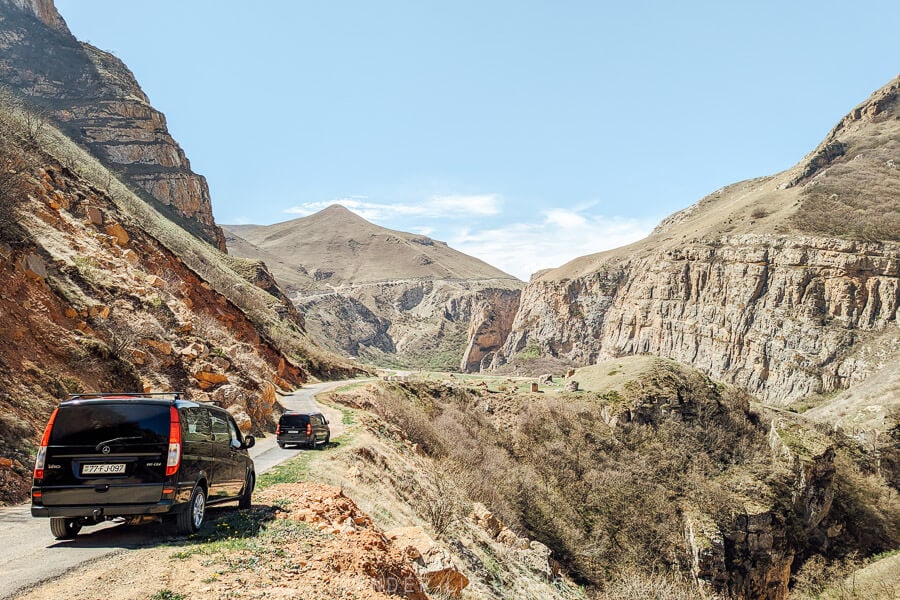
Baku to Khinaliq by car
There are two options for getting to Khinaliq by car: Rent a vehicle and drive yourself, or hire a private driver.
If you opt to self-drive, please check conditions locally before you set out. Things can change rapidly in the mountains and road closures due to avalanches/landslides do happen. As long as you are an experienced and confident driver, you will find the journey to Khinaliq fine. I recommend using Local Rent to find an affordable rental car in Azerbaijan.
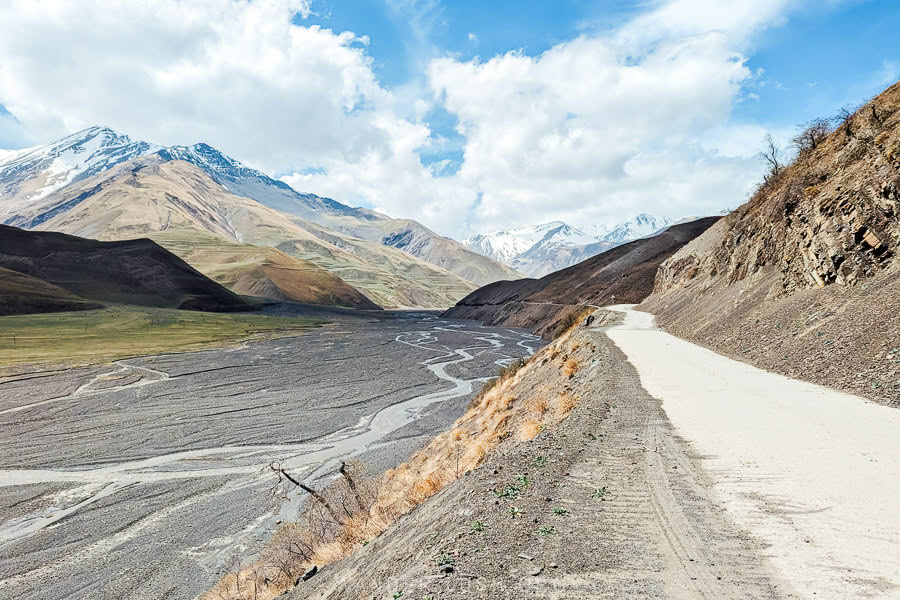
Baku to Khinaliq by bus
Quba is a mandatory transit point when travelling between Baku and Khinaliq using public transport.
Minibuses to Quba depart frequently (every 20-40 minutes starting from 7.30am) throughout the day from the International Bus Terminal in Baku. Travel time is around 3 hours and 20 minutes, and a ticket costs 5.30 AZN. Double-check times and prices on Biletim (route: Bakı-Quba).
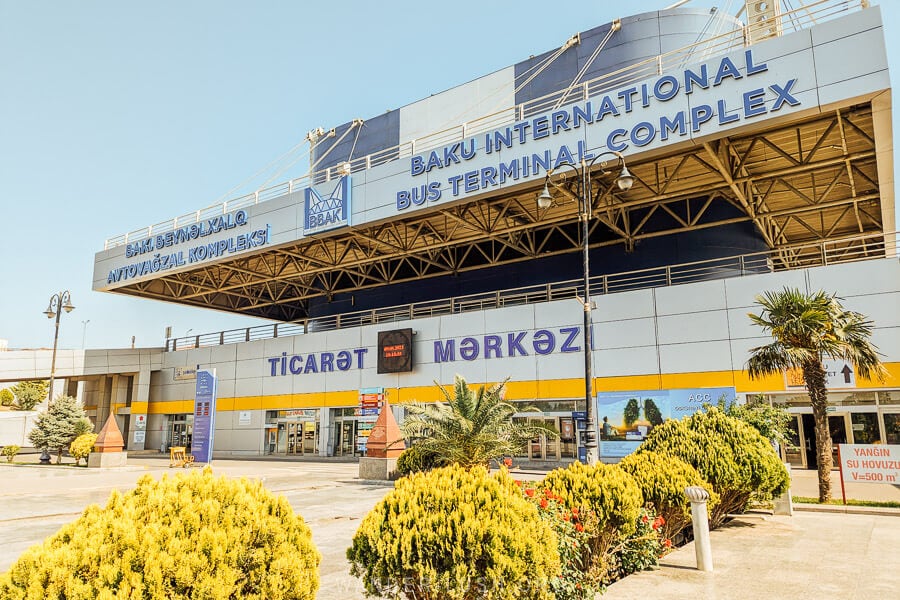
You have the option to spend a night in Quba and continue your journey the following morning, or you can carry on to Khinaliq on the same day. Quba is a small city, but if you have time, I do suggest stopping to see the Red Village and visit the carpet-weaving workshops.
There are no minivans to Khinaliq from Quba, so you will need to take a private car from here. Taxis (i.e. villagers returning home after doing business in the city) wait on the street adjacent to the Central Bus Station, not far from where the Baku vans terminate. Look for a car around this point.
To secure a seat in shared taxi, your safest bet is to show up in the early afternoon, between midday and roughly 4pm. Expect to pay 10-15 AZN per person or 40-60 AZN for the whole car.
Another option is to pre-arrange a transfer through your guesthouse in Khinaliq. The owner will ask around and find someone who is willing to save you a spot. The same applies for the return journey.
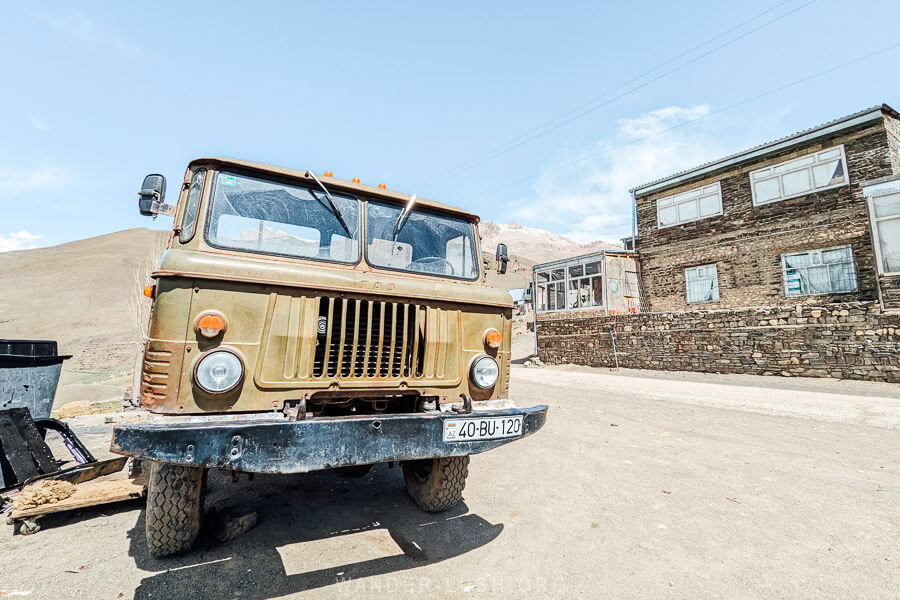
Day tours to Khinaliq from Baku
It is a long day of driving, but despite that I do think Khinaliq is a worthwhile day trip from Baku – especially if you opt for an itinerary that includes a bit of hiking and lunch in a family home.
My recommendations are:
- This hiking tour, which includes an accompanied trek from Galakhudat into Khinaliq – Bag Baku is a great company that I have personal experience with, so this would definitely be my top recommendation
- This Guba and Khinaliq Tour, which is more standard and includes 2 hours in the village, a homemade lunch, plus several stops on the way from Baku including Qecresh Forest
- This small group tour, which visits the Khizi ‘candy cane’ Mountains after Khinaliq
Where to stay in Khinaliq
Overnighting in a family home is part and parcel of the Khinaliq experience and not something to miss. Not that you have any other option – there are no hotels in Khinaliq.
When to go
The road to Khinaliq is technically open year-round. However, it is often impassable in deep winter due to heavy snowfall. For this reason, I recommend visiting Khinaliq between March and November.
Summer is an ideal time to visit if you plan on hiking. Spring is beautiful too, but it can be foggy and wet. Remember to pack something warm – even during the hottest months of July and August, temperatures dip overnight and not all guesthouses have heating.
Things to do in Khinaliq
Traditional architecture
The vernacular architecture in Khinaliq is specialised to the region and constitutes an important part of the village’s UNESCO status. Houses are traditionally built one on top of the other in a terraced formation. In Khinaliq, your courtyard is also your downstairs neighbour’s roof – so you had better take good care of it!
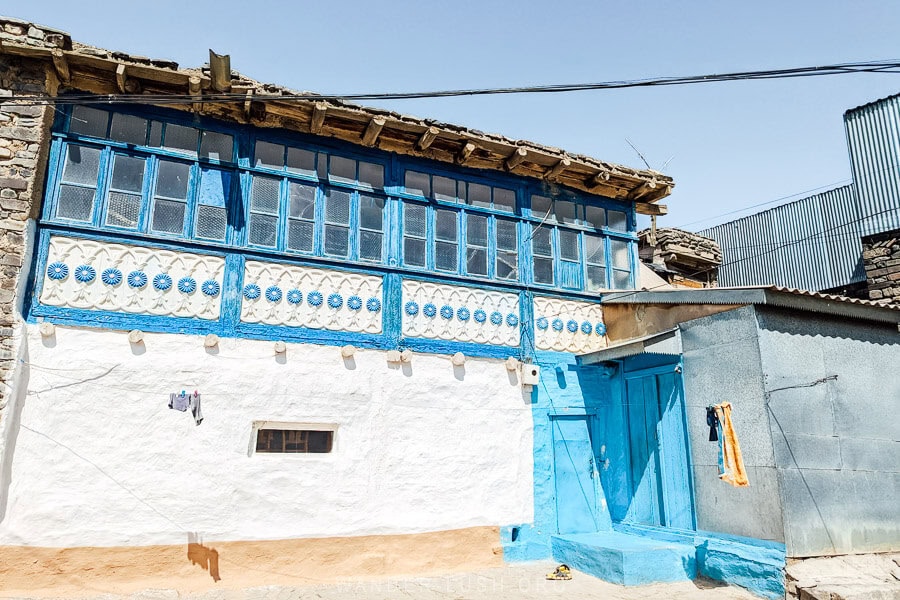
Incredibly, some of the structures you see in Khinaliq today were built two or three centuries ago – and they are still very much lived-in.
Many have of course been altered or added to for comfort and covered with stucco for durability.
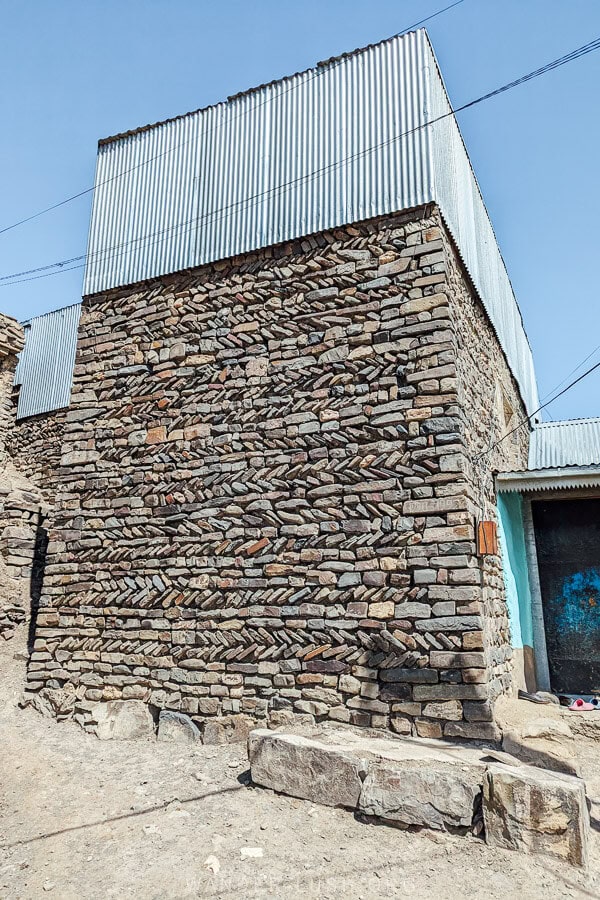
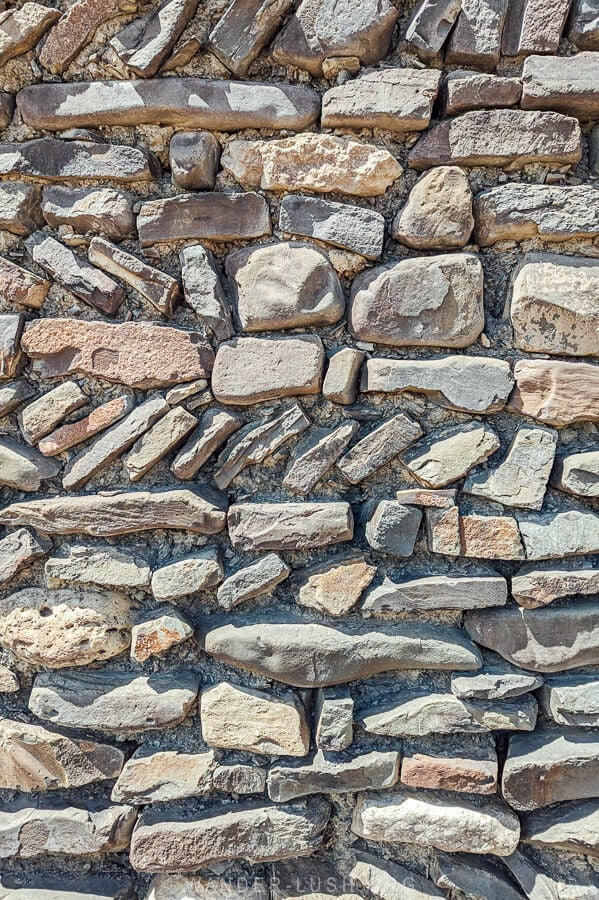
There are more than 350 stone houses in the village in total. Visitors are more than welcome to wander the sloping streets and small pathways to admire the facades.
Khinaliq Mosque
Islam is the official religion in Khinaliq as it is in the rest of Azerbaijan. But in practice, the belief code is a combination of pagan, Zoroastrian and Islamic beliefs.
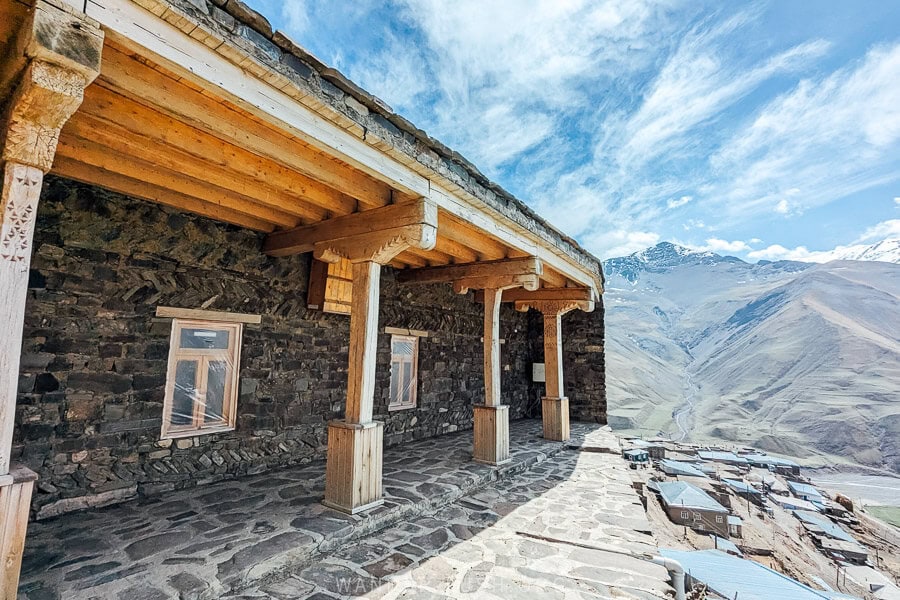
The Friday Mosque has an elevated position on the eastern side of the village, commanding breathtaking views of the hills and river valley below. In many ways it reminded me of the view of Georgia’s ancient tower houses that you find when standing on the hill in Ushguli.
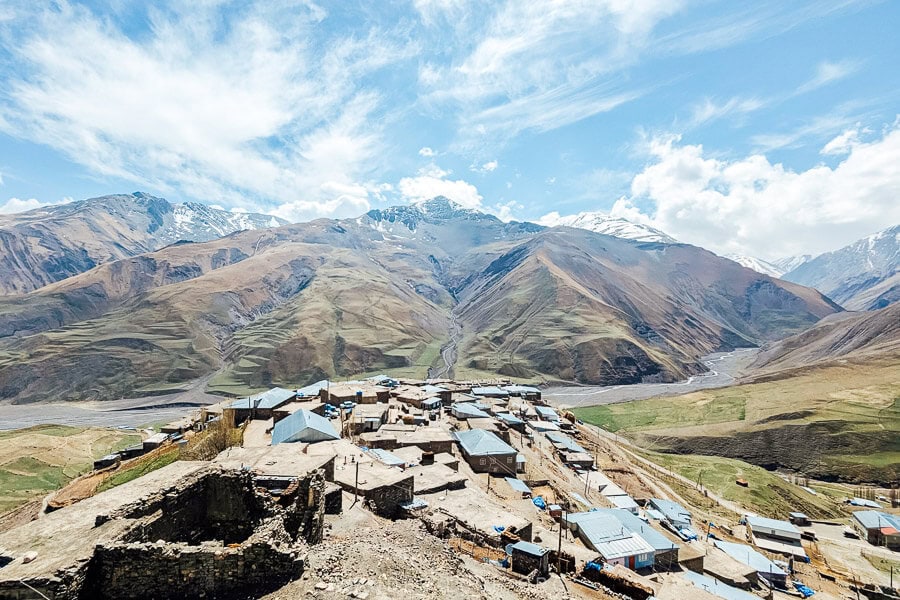
The mosque was recently restored and has a modern interior, with carved wooden pillars and dozens of beautiful carpets lining the floors.

You can see an Arabic inscription on one of the stones on the mosque’s facade.
Khinaliq’s two Museums
There are two museums in Khinaliq. Located inside a rather grand stone building that resembles a small castle, the History-Ethnography Museum is the main institution.
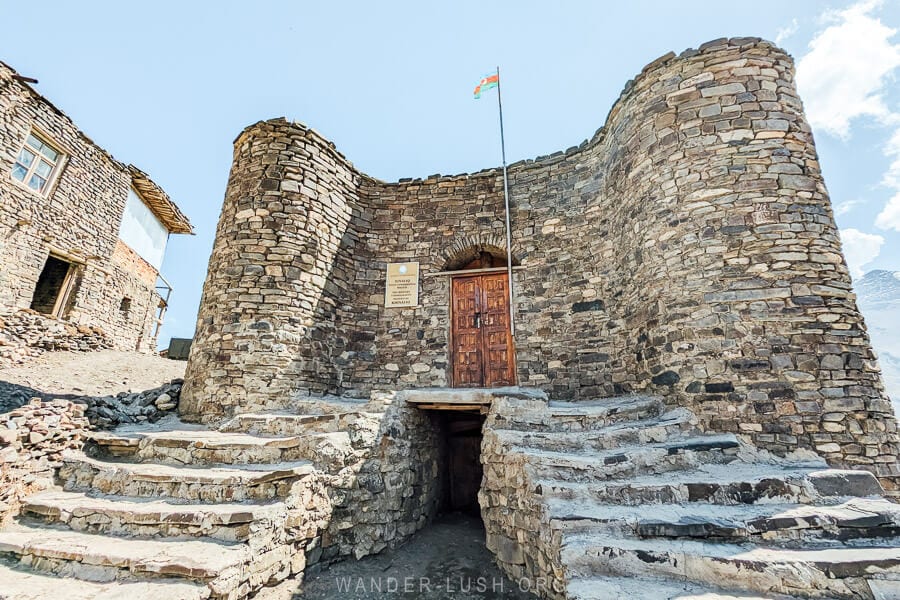
The exhibition here is quite interesting – for the most part, the museum resembles an antique store. Earthenware, samovars, leather shoes, woven carpets and more contemporary objects including vintage clocks from the Soviet period are arranged in a very aesthetically pleasing manner.
More precious archaeological finds from the area, including old coins and weapons, are kept safe under glass.
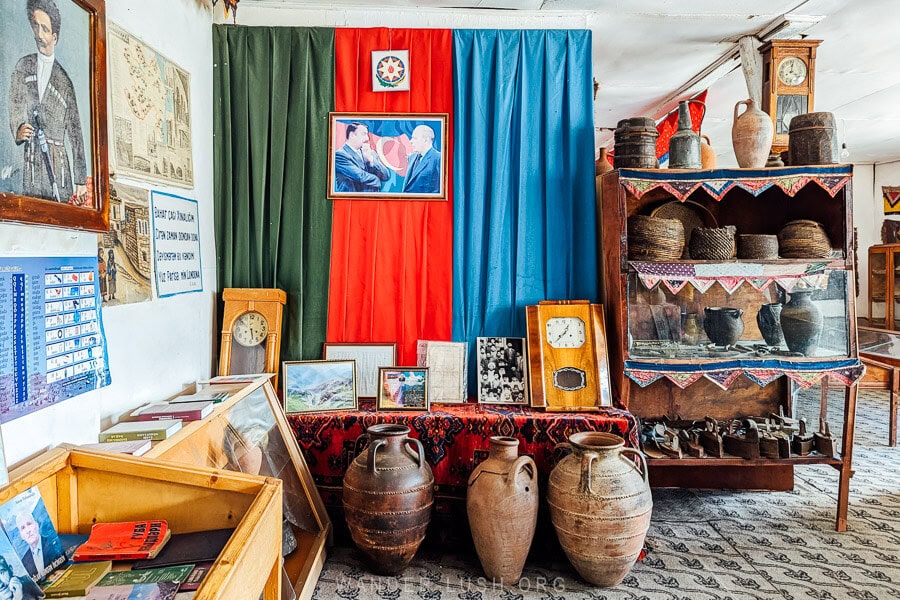
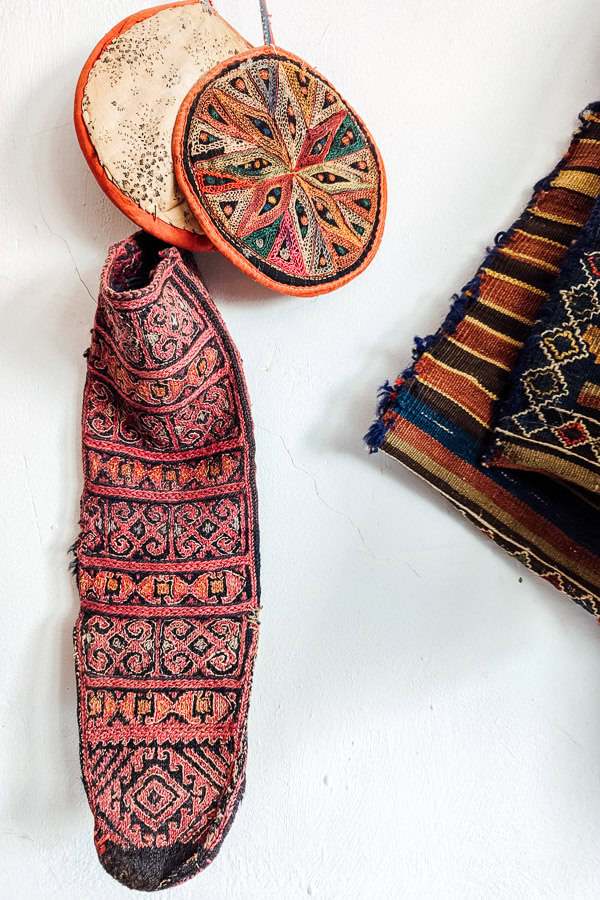
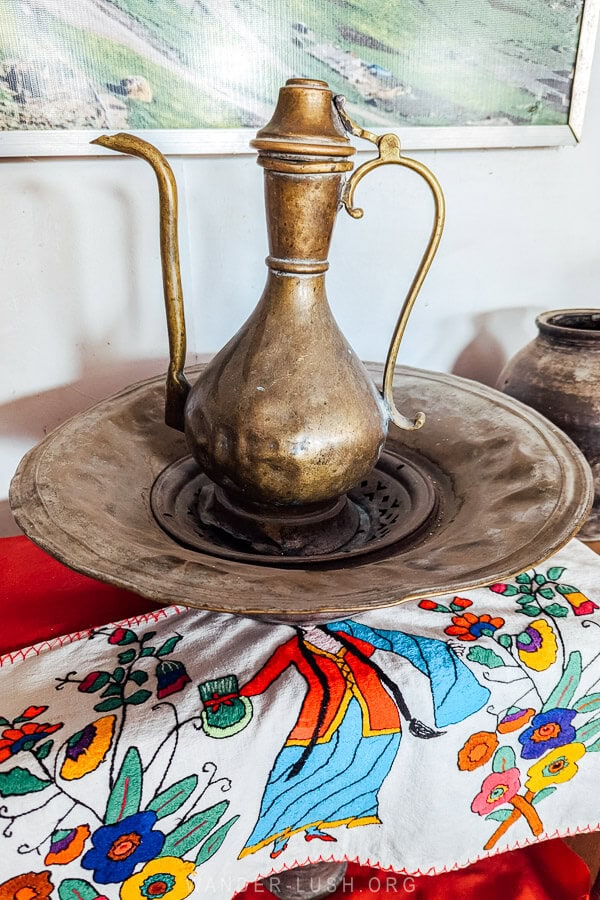
The second museum, the State History, Architecture and Ethnography Reserve, is located in a one-storey stucco building closer to the entrance to the village. It is much smaller, with a collection of carpets, copper plates and farming equipment.
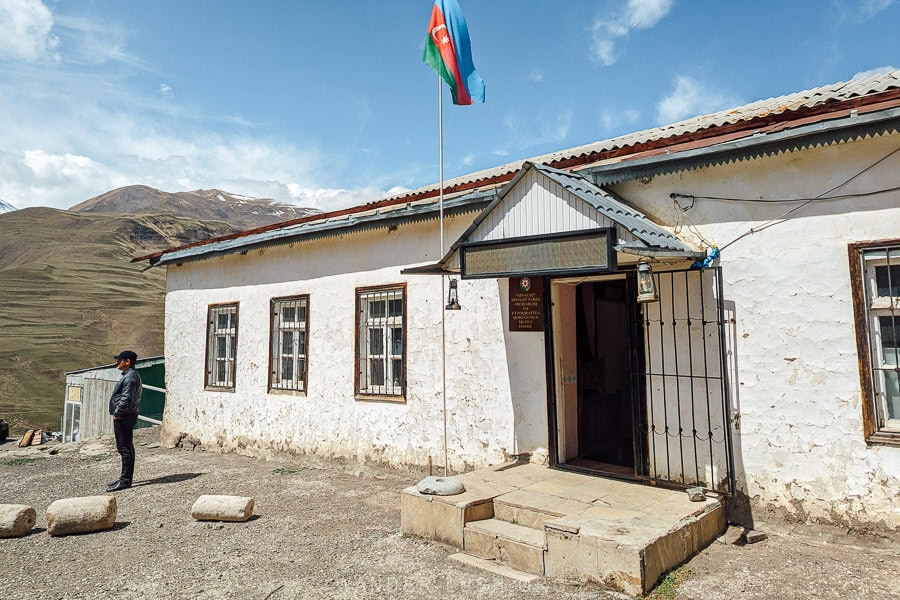
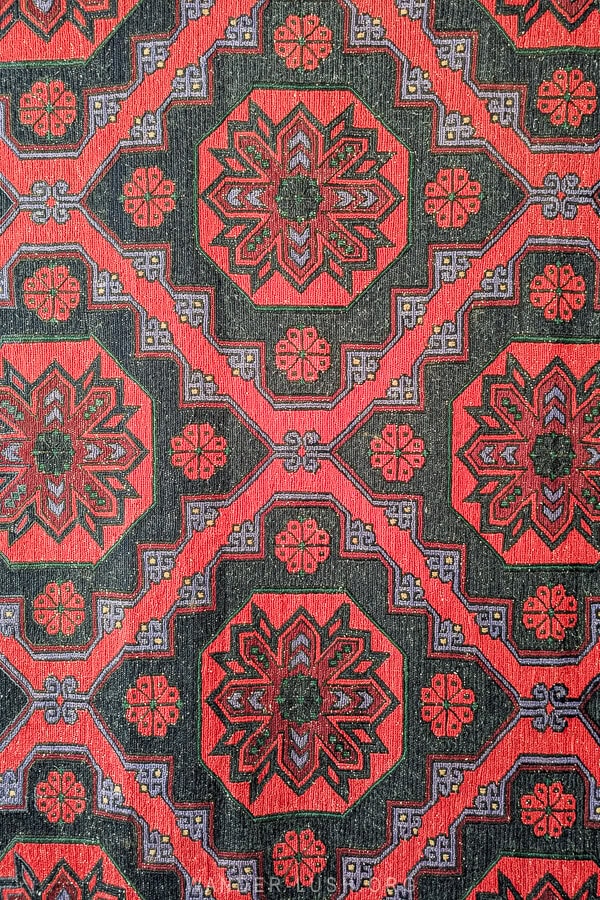
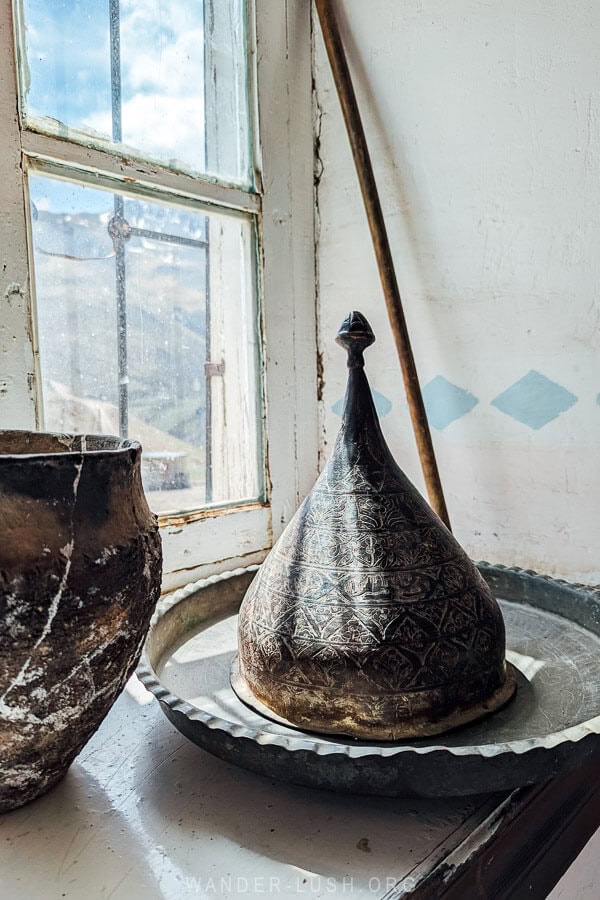
Both museums have sporadic opening hours. If you wish to visit one or both, it might be a good idea to ask your guesthouse to locate the caretaker. Entrance costs a couple of AZN per person.
Khinalig Zoroastrian Temple
On the outskirts of the village – in the shadow of Mount Shahdagh – there is a reconstructed Zoroastrian Temple that takes the title of the highest fire-worship temple in the world.
Prior permission is required to visit the site – I assume because of its location close to the Russian border. It is not clear where applications should be lodged, though. If you have any information on this, please share your tips in the comments section below.
If you are interested in hiking to the temple, you can try asking your guesthouse for information. Note that it takes a couple of days for a permit to be granted, so some forward planning is required here.
Carpet weaving & traditional crafts
Carpet weaving is an important part of the culture in Khinaliq just as it is all over Azerbaijan. When you visit a home for a meal or stay in a guesthouse, you will no doubt notice the walls and floors are covered with wool carpets – both for decoration and for warmth.
A selection of carpets can be found at both of the abovementioned museums.
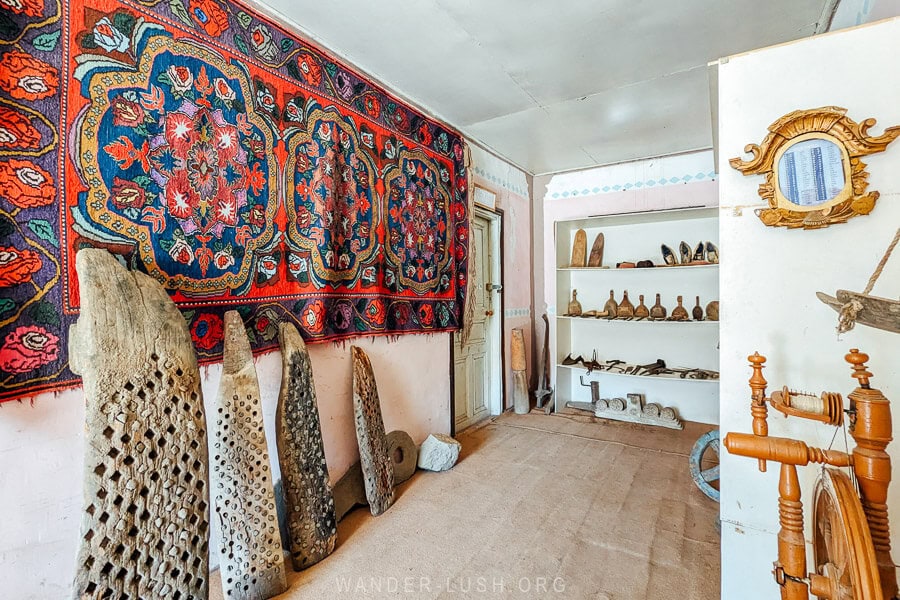
During my visit, I was lucky enough to meet a group of women spinning sheep’s wool and knitting traditional house slipper-socks known as jorab.
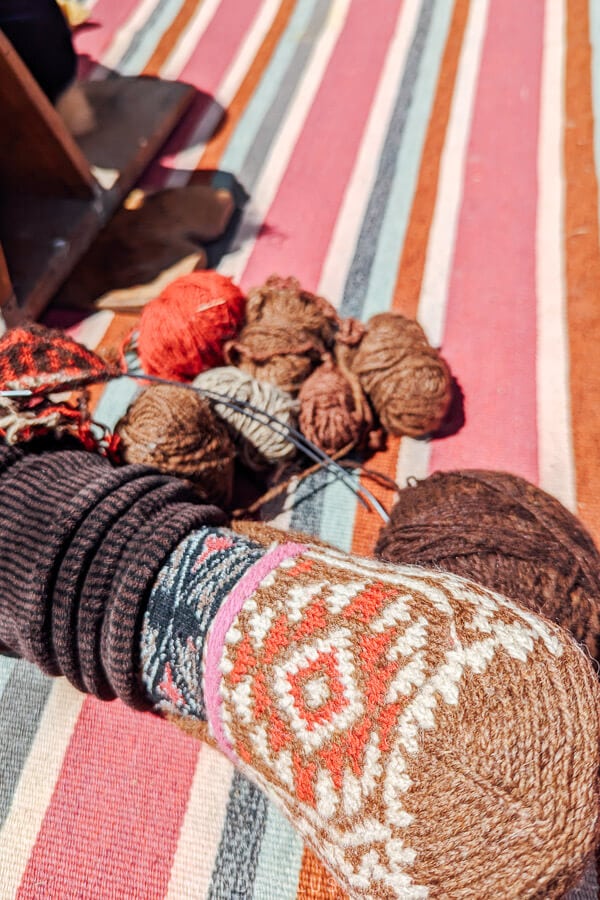
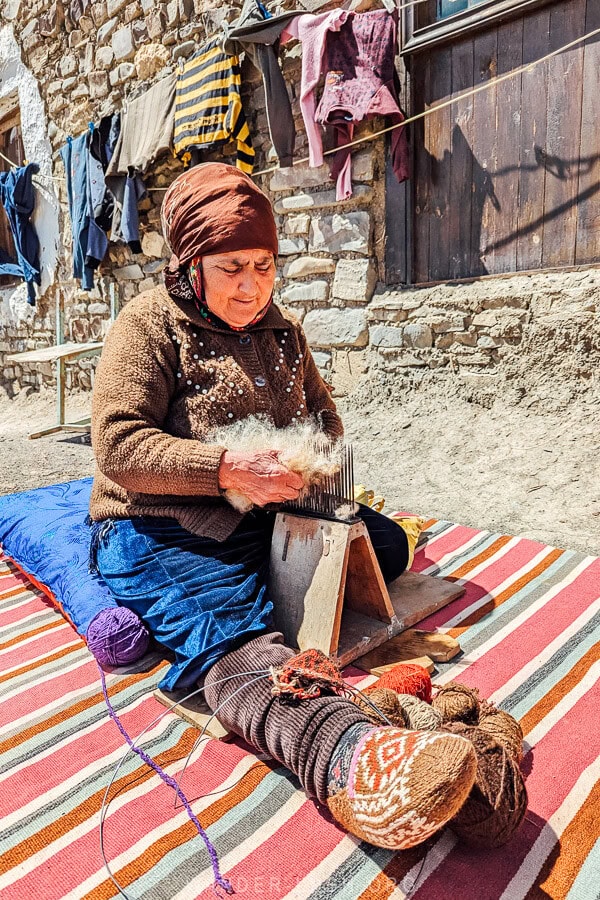
If you are interested in buying a pair, the social enterprise Azerbaijani Socks works with women in rural villages such as Khinaliq to develop traditional designs and provide a source of livelihood. They have a shop in Qusar, not far from Quba, plus an online store.
Homestay experiences
Eating, drinking and sleeping in a family run guesthouse is absolutely one of the best experiences you can have in Khinaliq. We didn’t overnight in the village this time, but we did enjoy a beautiful home-cooked meal prepared by one of the generous families who have opened their home to tourists.
The deconstructed plov (rice pilaf) they served us with juicy apricots and fall-off-the-bone lamb was one of the best meals I have ever had in Azerbaijan.

If you don’t plan to stay the night, I would highly recommend pre-arranging lunch at one of the guesthouses like we did. Most day tours from Baku also include this as part of the experience.
Khinaliq viewpoints
There are viewpoints all around the village where you can find panoramic vistas of Khinaliq and the mountains. For the most iconic views of Khinaliq sitting on its isthmus-like plateau (pictured at the top), walk to this viewpoint just beyond the last houses on the north-east side of the village.
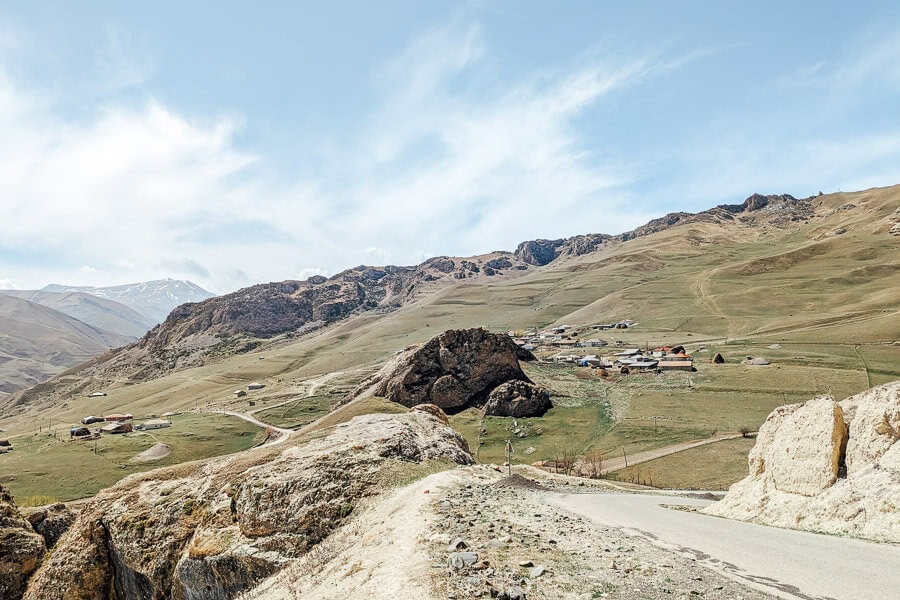
This alternative viewpoint can be accessed on foot or by taxi.
Hiking in Khinaliq
One of Azerbaijan’s most popular hikes, the Khinalig-Galakhudat trail connects Khinaliq with the neighbouring village of Galakhudat (Kalaykhudat) to the east. It is a 16-kilometre hike that takes around 7-8 hours round-trip, and it can be done in either direction.
The way is fully marked, but if you prefer to go with a guide, this day hiking trip with Bag Baku is the best option.
It is also possible to hike from Khinalig to Laza, a small village to the north of Khinaliq.
Khinaliq travel tips
Food & drink: There are no restaurants as such in Khinaliq. If you are overnighting, you should organise to eat your meals at your guesthouse. If you are coming on an organised day trip, lunch will be pre-arranged with one of these families. There is a supermarket in the village that sells bottled water, snacks, and basic supplies.
ATMs & money: There are no ATMs in Khinaliq. The closest banks/cash machines are in Quba. Small guesthouses do not accept card payment, so remember to bring enough cash with you to cover your accommodation and food costs.
WIFI & mobile coverage: My local Azercell SIM card worked just fine in Khinaliq. Guesthouses may or may not have WIFI – it is much easier to buy your own SIM with data just in case.
Have you travelled to Khinaliq? What was your experience? If you have any tips to share for my next visit, please leave them in the comments below.
